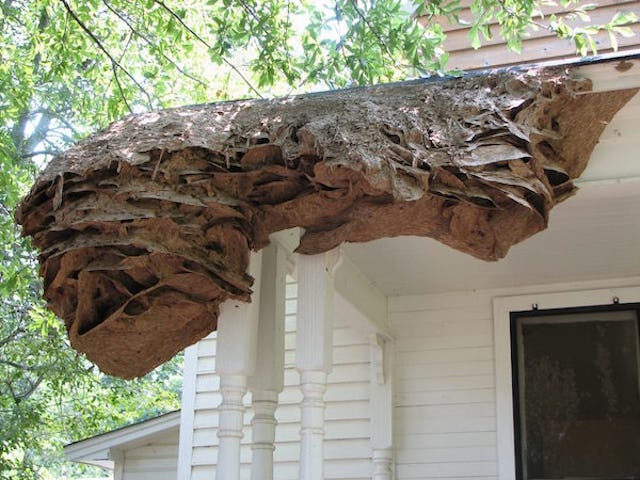Wasps Are Building Nests The Size Of Cars Thanks To Climate Change

Worried about climate change? Add swarms of thousands of yellow jackets to your list
An entomologist in Alabama warns that due to the mild winter, the state may well see an outbreak of yellow jacket “super nests,” which can grow as big as a car and contain up to 15,000 stinging insects.
Fan-freaking-tastic.
The last time there was a widely-reported outbreak of these super nests was in 2006, after another mild winter, and researchers believe that these conditions could worsen with global warming and climate change. Check out this nest trying to take over a whole house.
Image via Charles Ray
And this one filling up a whole car. Phew. Nightmare fodder.
Charles Ray
Oh, and another one taking up residence inside an old mattress. Super cool.
Charles Ray
Charles Ray, an entomologist working with the Alabama Cooperative Extension System, talked to Auburn University about the phenomenon and why it happens.
He explained that the large nests, called perennial nests, happen when mild winters don’t kill the bugs off, or ruin their food supply. So instead of the queens finding new spots for a yearly nest, they simply expand their current nest, sometimes with multiple queens ruling the roost.
A normal yellow jacket nest should contain from 4,000 to 5,000 insects, and goes through an annual lifecycle that controls the population. Super nests are huge freaks of nature.
“These perennial nests may be several feet wide and have many thousands of workers, far more than an average nest,” Ray said. “We have found them attached to home exteriors and other places you might not expect to find yellow jackets.”
Like, literally climbing up the side of a house. Neato!
Charles Ray
How big can these nests get? You kind of don’t want to know.
“The most workers I have counted in a perennial nest is about 15,000 or about 3 to 4 times more than a normal nest,” he said. “However, one nest in South Carolina was documented with more 250,000 workers.”
We told you that you probably didn’t want to know.
The last time that these super nests were spotted in Alabama was in 2006 — Ray tracked about 90 of them. This year, it’s still early in the season, but Ray has already tracked two nests, with rumors of more. If the trend continues, there could be more than 90 of these enormous nests by fall.
“If we are seeing them a month sooner than we did in 2006, I am very concerned that there will be a large number of them in the state,” he said. “The nests I have seen this year already have more than 10,000 workers and are expanding rapidly.”
Nerdist reports that 15 nests have been spotted as of the beginning of July.
Ray also said that the region affected by the nests is spreading this year.
“In previous years, I’ve never seen one north of Talladega. (This year) I’ve got two possible in the Tennessee Valley,” he told a local news station. “It looks like we may be having another break out year.”
Here are three that Ray has found in July.
Image via Charles Ray
image via Charles Ray
Image via Charles Ray
What should you do if you find a super nest? First of all, stay away. Even though Ray says that super nest colonies are less aggressive than other yellow jackets, they can still sting — in 2006, three people where seriously injured by the creatures.
Secondly, contact Ray so that he can track and study the phenomenon: raychah@aces.edu or at raychah@auburn.edu.
As for removal? Ray says absolutely don’t try to take on the task yourself — call a professional. Although even some commercial rigs won’t touch these giant nests.
This is just one more issue that is probably arising out of climate change. Not to mention our issues with disappearing bees, which is very likely due to stuff humans have caused.